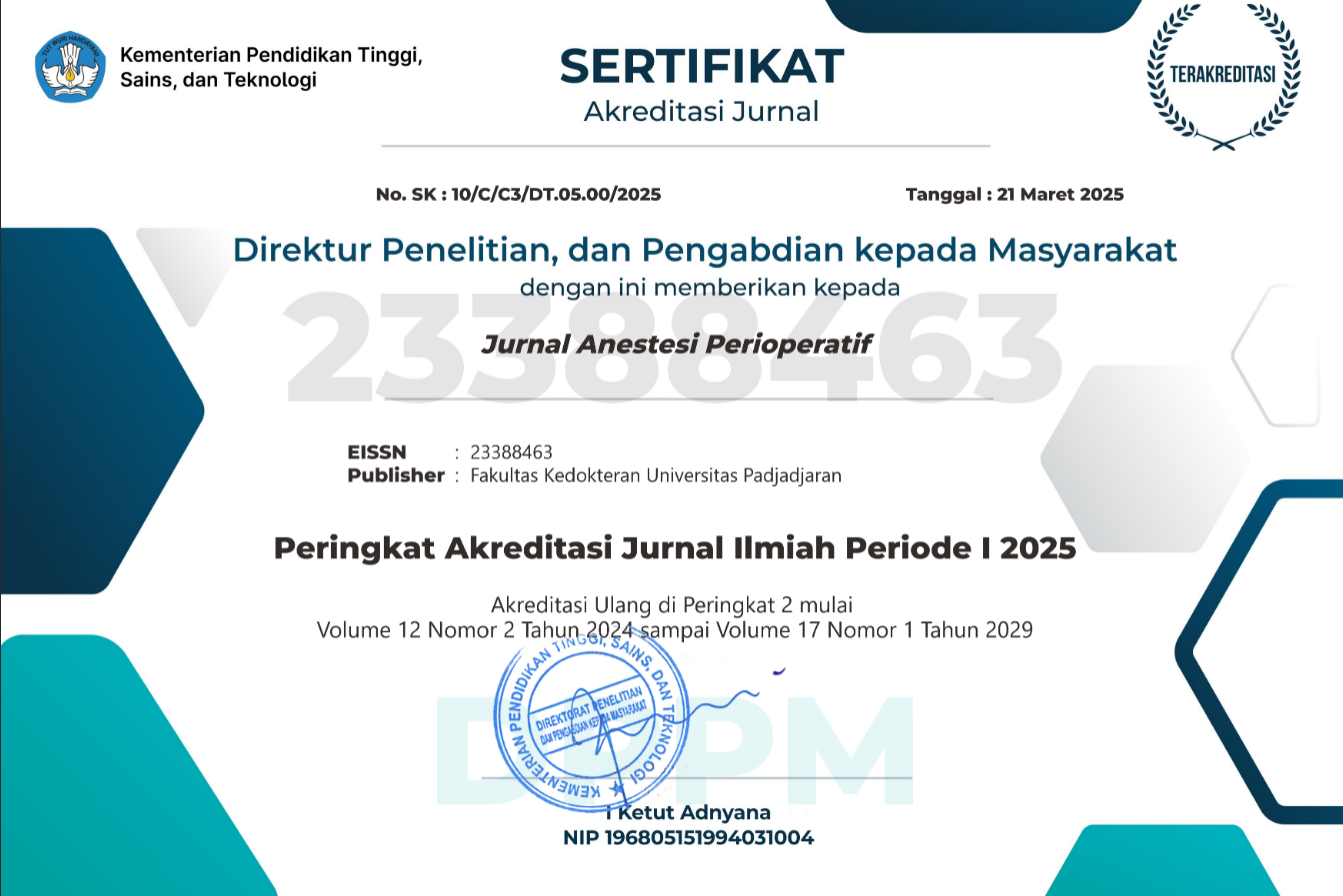Insidensi dan Faktor Risiko Hipotensi pada Pasien yang Menjalani Seksio Sesarea dengan Anestesi Spinal di Rumah Sakit Dr. Hasan Sadikin Bandung
Abstract
Hipotensi merupakan komplikasi yang sering terjadi setelah tindakan anestesi spinal pada pasien seksio sesarea. Hipotensi terjadi akibat blokade simpatis terhadap aktivitas vasomotor pembuluh darah serta penekanan aorta dan vena kava inferior oleh uterus yang membesar terutama pada saat pasien telentang. Tujuan penelitian ini adalah mengetahui insidensi hipotensi dan faktor risiko yang berhubungan dengan kejadian hipotensi pada pasien yang menjalani seksio sesarea dengan anestesi spinal di Rumah Sakit Dr. Hasan Sadikin Bandung. Penelitian observasional potong lintang (cross sectional) ini dilakukan pada 90 subjek pasien yang menjalani seksio sesarea dengan anestesi spinal pada periode bulan April–Mei 2015. Pengolahan data dengan analisis univariabel untuk melihat gambaran proporsi variabel masing-masing yang disajikan secara deskriptif. Hasil penelitian menunjukkan insidensi hipotensi 49%. Faktor risiko yang menyebabkan hipotensi maternal menunjukkan hasil yang tidak signifikan berhubungan dengan kejadian hipotensi (p>0,05). Perbedaan insidensi hipotensi maternal setelah tindakan anestesi spinal dan faktor risiko yang memengaruhinya dengan penelitian sebelumnya karena perbedaan jumlah sampel penelitian, perbedaan definisi hasil yang digunakan, perbedaan tempat penelitian, dan perbedaan metode pengumpulan data.
Kata kunci: Anestesi spinal, faktor risiko, hipotensi, insidensi, seksio sesarea
Incidence and Risk Factors of Hypotension in Patients Undergoing Cesarean Section with Spinal Anesthesia in Dr. Hasan Sadikin General Hospital Bandung
Abstract
The most common serious complication associated with spinal anesthesia for C-section is hypotension. These hemodynamic changes result from a blockade of sympathetic vasomotor activity that is accentuated by the compression of the aorta and inferior vena cava by the gravid uterus when the patient is in the supine position. The purpose of this study was to describe the incidence of hypotension in patients undergoing cesarean section with spinal anesthesia in Dr. Hasan Sadikin General Hospital Bandung and to obtain a description of risk factors associated with the incidence of hypotension. A cross–sectional observational study was conducted on 90 subjects consisting of patients undergoing cesarean section with spinal anesthesia during the period of April–May 2015. The data processing performed was the univariable analysis to see the picture of the proportion of each variable, which were presented descriptively. The results showed 49% incidence of hypotension. There was an insignificant association between the risk factors of maternal hypotension after spinal anesthesia for cesarean section insignificant association with the incidence of hypotension (p>0.05). Differences in the incidence of maternal hypotension after spinal anesthesia and risk factors as stated in this study when compared to previous studies are due to differences sample size, definitions, place, and data collection methods.
Key words: Cesarean section, hypotension, incidence, risk factors, spinal anesthesia
DOI: 10.15851/jap.v4n1.745
Keywords
Full Text:
PDFDOI: https://doi.org/10.15851/jap.v4n1.745
Article Metrics
Abstract view : 13061 timesPDF - 7706 times
This Journal indexed by

JAP is licensed under a Creative Commons Attribution-NonCommercial 4.0 International License
View My Stats



